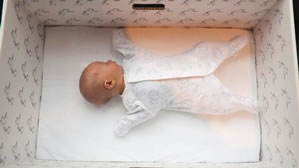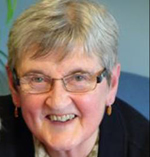With many health care systems and the services they are intended to provide, there is often a huge disconnect between the original concept and the service provided. It seems so often that the programs are designed around the process rather than the service that is provided. The result often leaves health care providers and families confused and the service a shadow of what is needed.
I recently read the following article in the Globe and Mail regarding a program of pre-natal care in Finland. It is so simple and practical. We need programs like this in Canada.
June 5, 2013
Why Canadian babies should sleep in cardboard boxes like Finnish babies do
By ANDRÉ PICARD
Posted with permission from The Globe and Mail
Compared to Finland’s generous and forward-thinking approach to child health, Canada looks paltry and stingy
 Earlier this week the BBC News Magazine ran an astonishing story entitled: “Why Finnish babies sleep in cardboard boxes.” It was the tale of the “maternity package,” a simple cardboard box loaded with goodies that every expectant mother receives in Finland.
Earlier this week the BBC News Magazine ran an astonishing story entitled: “Why Finnish babies sleep in cardboard boxes.” It was the tale of the “maternity package,” a simple cardboard box loaded with goodies that every expectant mother receives in Finland.
The gift from the state contains clothes, a snowsuit, bath products, cloth diapers, books, bedding and a mattress. Traditionally, newborns in the Nordic country spend many of their first naps and sleeps in that cardboard box, a practice related in the catchy headline.
While the contents of the box are significant and useful, even more important is the symbolism. The cardboard box says: “Every child matters. Every family matters.”
That philosophy is the cornerstone of Finnish public policy.
It is not the box per se, but a wide range of child-centred and family-friendly social policies giving Finland what are arguably the healthiest children in the world.
It is a philosophy that also helps explain why Finland has the world’s happiest mothers, according to Save The Children2.
Which invites the question: How does Canada compare?
Well, to begin with, our moms come in at a mediocre 20th place on the happiness ranking.
More importantly, Finland has an infant mortality rate of 2.3 per 1,000 live births. Canada’s rate is a shameful 5.7 per 1,000 – more than double.
Why?
It begins with the box – or the message in the box.
To collect the maternity package, Finnish moms-to-be must visit a maternity clinic. The contents, worth several hundred dollars, are an enticement to seek care. (Women can opt for a cash payment of 140 euros, but few do.) Practically, that means every pregnant woman gets care: Not only medical interventions like ultrasound scans, but milk and fresh fruit. Prevention is the best way to reduce the number of low-birth-weight babies.
The box contains a book on how to breastfeed, and every new Finnish mom gets a home visit from a lactation consultant. In Canada, our primary care is lacking and well-baby visits are a rarity. Until not too long ago, new moms were sent home with formula.
In Finland, all new moms get nine months of maternity benefits – whether they work not. Daycare is provided at no cost, and parents who choose to forgo daycare get a cash subsidy.
In Canada, maternity benefits flow from the employment-insurance program. If you don’t pay in – meaning, essentially, you have a job with benefits – you can’t collect. The approach excludes students, many part-timers, the self-employed, those who are paid under the table, the unemployed and so on.
The only province that has state-funded daycare is Quebec, and parents still pay $7 a day (if they can find a spot). Many parents pay $40 to $50 daily for child care, a usurious amount.
For a long time, Canada had a baby bonus. It started at $5 for each of “Johnny Canuck’s offspring” after the Second World War and rose gradually until it was eliminated in the cost-cutting of the early 1990s.
Today, Canada has a universal child-care benefit of $100 a month (taxable) and a Canada child-tax benefit for parents of children under 6. There are supplements for low-income parents and those with children with disabilities.
These programs are paltry at best. They have helped reduce the breadth of poverty, but not its depths.
Countries like Finland simply do not allow children and families to wallow in poverty. It is socially and politically unacceptable.
They recognize, implicitly and explicitly in public policy, that there is a cost to child-rearing for individuals and a benefit to society more broadly if children are raised healthy. So they facilitate parenting with a range of supports in health care, childcare, education, housing and employment.
It all begins with a cardboard box, a symbol of commitment.
In Canada, we don’t have a family policy to speak of. We have a lot of rhetoric and very little concrete supports, financial or otherwise.
It’s every mom for herself. We don’t even provide a box of essentials, and that speaks volumes.
If you don’t get the building blocks right, then how do you produce a nation of healthy children?
 Trish Summerhayes
Trish Summerhayes
Publisher/Owner of Islandwoman.ca
See all articles by Trish Summerhayes




wow, what a concept. trish. thanks for telling me about your island woman site. looking forward to your next articles. h
Thanks Hazel, glad you enjoyed the site
This is amazing. I also heard a CBC program a month or so ago about elder-care in Norway(? I think). They believe that just because you are old, doesn’t mean you should get shuffled off to a recliner in front of the TV. Apparently we should be taking a really long look at the policies in these Nordic countries and trying to put some into play here in Canada!
Thans Angelina for your comment,I missed that TV program What is the secret that the Nordic countries know that we in Canada seem to be missing .
Wow Trish! So true. Well written. What is the solution? Where do we start?
I wish I had the answer to your question. Maybe if we can get the story out in our own media circles perhaps we could create a bit of a ground swell. Smallest step !!